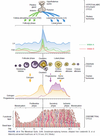Module 5.3 Reproductive Flashcards
1
Q
Describe the phases of the menstrual cycle (overview)
A
- The menstrual (ovarian) cycle consists of ovulation, which occurs in two phases: the follicular/proliferative and the luteal/secretory phase and each lasts about 14 days.
- Ovulation occurs between the follicular and luteal phases.
- If implantation of the blastocyst does not occur in the late luteal phase, menstruation (menses) occurs, also known as the ischemic/menstrual phase

2
Q
What occurs during the follicular/proliferative phase of menstruation?
A
- During this phase GnRH from hypothalamus → ↑ FSH from pituitary gland → ↑ sensitivity of the ovarian follicle to further FSH
- During this time estrogen is also ↑ing, & combines w/ FSH → production of LH receptors on granulosa cells → rapid secretion of follicular estrogen
- ↑’d estrogen lvls → ↓’d FSH lvls + causes endometrial cell proliferation + ↑’d LH
- At about day 14, during ovulation, lvls of FSH, LH and estrogen peak
- During the late follicular phase, there is an ↑ in androgen lvls → increased libido at the point of ovulation

3
Q
What occurs during the luteal/secretory phase of menstruation?
A
- During this phase, the ovarian follicle begins its transformation into a corpus luteum.
- Anterior pituitary secretes LH which stimulates the corpus luteum to secrete progesterone, which in turn initiates the secretory phase of endometrial development.
- If conception occurs, the nutrient-laden endometrium is ready for implantation
- Human chorionic gonadotropin (HCG) is
secreted 3 days after fertilization by the blastocytes and maintains the corpus luteum once implantation occurs at about day 6 or 7. - If conception and implantation do not occur, the
corpus luteum degenerates and ceases production of progesterone and estrogen. Without them, the endometrium becomes ischemic (blood-starved) and disintegrates. - Menstruation then occurs—the ischemic/ menstrual
phase—marking the beginning of another cycle

4
Q
What is the function of testosterone in males?
A
- Testosterone is produced in the Leydig cells, which are found adjacent to the seminiferous tubules of the testes.
- Testosterone promotes the production of spermatozoa, secretion from the accessory sex glands, acquisition of male secondary characteristics, and affects nervous and skeletal tissue, bone marrow, skin, and hair.

5
Q
What is the function of androgens in males?
A
- Androgens are steroid hormones that control the expression and maintenance of male sexual characteristics. Testosterone and dihydrotestosterone are the most potent androgens while androstenedione and dehydroepiandrosterone (DHEA) occur in small amounts and are weaker androgens.
- They are responsible for fetal differentiation and development of the male urogenital system and effects on the fetal brain. Around puberty androgens cause the sex organs to grow and secondary sex characteristics to develop.

6
Q
What is the function of estrogen in women?
A
- Estrogen has numerous biologic effects and is needed for maturation of reproductive organs, development of secondary sex characteristics, closure of long bones after the pubertal growth spurt, regulation of the menstrual cycle, and endometrial regeneration after menstruation.
- Estrogen also has metabolic effects on the bones, liver, blood vessels, brain and central nervous system, kidneys, and skin.

7
Q
What is the function of androgens in women?
A
- Some androgens (dehydroepiandrosterone and its metabolite androstenedione) are precursors of estrogens (estrone, estradiol).
- At puberty, androgens contribute to the skeletal growth spurt and cause the growth of pubic and axillary hair.
- The androgens also activate sebaceous glands, accounting for some cases of acne during puberty, and play a role in libido.

8
Q
What is the function of progesterone in women?
A
Plays a major role in pregnancy and:
- maintains the thickened endometrium
- relaxes smooth muscle in the myometrium, which prevents premature contractions and
helps the uterus expand - thickens (hypertrophy) the myometrium, which prepares it for the muscular work of labor
- promotes the growth of lobules and alveoli in the breast in preparation for lactation but prevents lactation until the fetus is born
- prevents additional maturation of ova by way of
suppressing FSH and LH, thereby stopping the menstrual cycle - provides immune modulation allowing tolerance against fetal antigens (the mother’s immune system does not attack the fetus); and preventing preterm birth
9
Q
Describe the regulation of androgen production and spermatogenesis via the CNS, hypothalamus, anterior pituitary, the testes, and androgen sensitive organs in males
A
- Stress may increase or inhibit hypothalamic activity
- The hypothalamus regulates GnRH synthesis and is released in pulses (about every 3 hours to the pituitary gland)
- Norepi stimulates GnRH secretion
- Serotonin & dopamine inhibits GnRH secretion
- GnRH binds to the anterior pituitary gland & stimulates the synthesis & secretion of gonadotropins FSH & LH
- LH acts on Leydig cells to regulate testosterone secretion
- FSH acts on the seminiferous tubule to promote spermatogenesis
- FSH is inhibited by the Sertoli cells of the seminiferous tubule via inhibin
- Inhibin regulates pituitary FSH levels
- It also facilities LH stimulation in Leydig cells

Any disruption along the HPT axis may lead to hypogonadism or infertility


